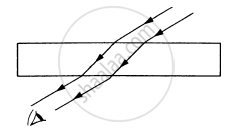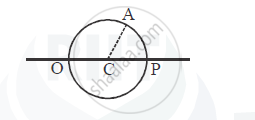Advertisements
Advertisements
Question
The refractive index of a material changes by 0.014 as the colour of the light changes from red to violet. A rectangular slab of height 2.00 cm made of this material is placed on a newspaper. When viewed normally in yellow light, the letters appear 1.32 cm below the top surface of the slab. Calculate the dispersive power of the material.
Solution
Given:-
Difference in the refractive indices of violet and red lights = 0.014
Let μv and μr be the refractive indices of violet and red colours.
Thus, we have:-
μv − μr = 0.014
Now,
Real depth of the newspaper = 2.00 cm
Apparent depth of the newspaper = 1.32 cm
\[\text{Refractive index }= \frac{\text{Real depth}}{\text{Apparent depth}}\]
Refractive index for yellow light \[\left( \mu_y \right)\] is given by
\[ \mu_y = \frac{2 . 00}{1 . 32} = 1 . 515\]
Also,
Dispersive power, \[\omega = \frac{\mu_v - \mu_r}{\mu_y - 1}\]
\[= \frac{0 . 014}{1 . 515 - 1}\]
Or, \[\omega = \frac{0 . 014}{0 . 515} = 0 . 027\]
Thus, the dispersive power of the material is 0.027.
APPEARS IN
RELATED QUESTIONS
Light of wavelength 5000 Å propagating in air gets partly reflected from the surface of water. How will the wavelengths and frequencies of the reflected and refracted light be affected?
A tank is filled with water to a height of 12.5 cm. The apparent depth of a needle lying at the bottom of the tank is measured by a microscope to be 9.4 cm. What is the refractive index of water? If water is replaced by a liquid of refractive index 1.63 up to the same height, by what distance would the microscope have to be moved to focus on the needle again?
A narrow beam of light passes through a slab obliquely and is then received by an eye following figure. The index of refraction of the material in the slab fluctuates slowly with time. How will it appear to the eye? The twinkling of stars has a similar explanation.

A point object is placed at a distance of 30 cm from a convex mirror of focal length 30 cm. The image will form at
Figure shows a transparent hemisphere of radius 3.0 cm made of a material of refractive index 2.0. (a) A narrow beam of parallel rays is incident on the hemisphere as shown in the figure. Are the rays totally reflected at the plane surface? (b) Find the image formed by the refraction at the first surface. (c) Find the image formed by the reflection or by the refraction at the plane surface. (d) Trace qualitatively the final rays as they come out of the hemisphere.

A point ‘O’ marked on the surface of a glass sphere of diameter 20 cm is viewed through glass from the position directly opposite to the point O. If the refractive index of the glass is 1.5, find the position of the image formed. Also, draw the ray diagram for the formation of the image.

Stars twinkle due to ______.
What is optical path? Obtain the equation for optical path of a medium of thickness d and refractive index n.
What is angle of deviation due to refraction?
What is a principle of reversibility?
What is looming?
What is Snell’s window?
Write a note on optical fibre.
A light travels through water in the beaker. The height of water column is 'h'. Refractive index of water is 'μw'. If c is velocity of light in air, the time taken by light to travel through water will ______.
A ray of light passes through equilateral prism such that the angle of incidence is equal to angle of emergence and each of these angles is equal to `(3/4)^"th"` the angle of prism. The angle of deviation is ______.
When a ray of light is incident normally on one refracting surface of an equilateral prism of refractive index 1.5, the emerging ray ______.
`[sin^-1(1/1.5)=41.8^circ]`
For a rectangular slab, refraction takes place at ______.
There are certain material developed in laboratories which have a negative refractive index (Figure). A ray incident from air (medium 1) into such a medium (medium 2) shall follow a path given by.
A beam of light travels from air into a medium. Its speed and wavelength in the medium are 1.5 × 108 ms-1 and 230 nm respectively. The wavelength of light in the air will be ______.
